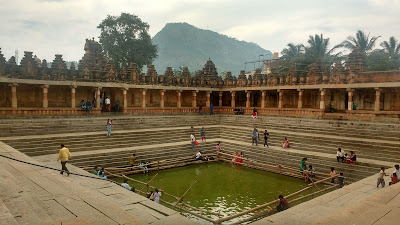Architectural Harmony Of The Bhoga Nandeeshwara Temple

Introduction The village of Nandi at the foot of the Nandi Hills, about 60kms to the north of Bengaluru, is home to the beautiful temple of Bhoga Nandeeshwara. The temple, dating back to the 9th century, features elements related to the Dravidian, Hoysala and Vijayanagara schools of architecture. The temple is a fantastic example of the cumulative harmony of culture - each of the elements is distinct and yet is integral to the entire monument without over-riding any other element. This would be in direct contrast to monuments (especially those related to the Sultanates and Mughals) where older monuments were destroyed and their components used to create a new one. The Nandi hills and the beautiful Pinakini Kote The Bhoga Nandeeshwara Temple complex can be divided into four sections: the outer enclave, the temples, the halls and the tank. All sections other than the main temple bear a prominent Vijayanagara badge and are the more recent (about 16th century) additions to the co

